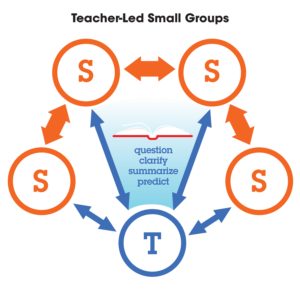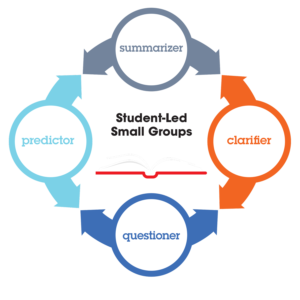Share this article.
Deep learning—of anything—requires strong reading skills. And we, at Elevated Achievement, are here to share with you one of the most effective reading strategies for all students.
We, as teachers like you, want to ensure that when our students think of reading, they don’t think that it means they start with the first word of the text and get to the last word as fast as possible so they can say, “I’ve finished reading!” We know that this is a waste of time and energy because reading is about comprehension and gathering information from text. This means understanding what the author is saying—both directly and between the lines.
For your students to be successful readers and take ownership of their reading—in class, at home, on their own—they need a process that helps them routinely think about and reflect on how they understand and make meaning from text.
 One of the most effective ways for students to take ownership of their reading is to teach them how to utilize the Reciprocal Teaching strategy. This strategy is a routine process that guides students to naturally talk over what they are reading with someone else—it could be with us, the teacher, it could be with classmates, it could be with family or friends. This is a back-and-forth conversation that will deepen each reader’s understanding of the text. Once your students understand the process, they, themselves, can lead this conversation.
One of the most effective ways for students to take ownership of their reading is to teach them how to utilize the Reciprocal Teaching strategy. This strategy is a routine process that guides students to naturally talk over what they are reading with someone else—it could be with us, the teacher, it could be with classmates, it could be with family or friends. This is a back-and-forth conversation that will deepen each reader’s understanding of the text. Once your students understand the process, they, themselves, can lead this conversation.
“Reciprocal Teaching was devised as an instructional process to teach students cognitive strategies that might lead to improved learning outcomes (initially in reading comprehension)…The aim, therefore, is to help students actively bring meaning to the written word, and assist them to learn to master their own learning and thinking.” Hattie, 2009
What Is the Goal of Reciprocal Teaching?
The goal is to explicitly practice four reading comprehension strategies: questioning, clarifying, summarizing, and predicting. The sequence for reciprocal teaching is the same if led by the teacher or by the student. However, the process—who is doing what—differs.
The Process for Reciprocal Teaching:
READING: The text is read aloud. Students listen, mark text.
QUESTIONING: Questions are asked. Students answer the questions and ask their own.
CLARIFYING: Clarifications are made. Students agree, disagree, and ask for other clarifications.
SUMMARIZING: Summary is given. Students agree, disagree, and add to it, if needed.
 PREDICTING: Predictions are made. Students agree, disagree, and add to it, if needed.
PREDICTING: Predictions are made. Students agree, disagree, and add to it, if needed.
How to Utilize Teacher-Led Small Groups
In teacher-led small groups, the teacher models the four strategies while guiding the students through the reading passage by…
- Reading the passage aloud.
- Asking students comprehension questions.
- Having students clarify words and phrases.
- Supporting students to summarize the passage.
- Having students use evidence to make predictions.
Students eventually take over the role of the teacher and model the strategies while guiding their peers through the section of the text by questioning, clarifying, summarizing, and predicting.
How to Utilize Student-Led Small Groups
In groups of four, students use the strategies to help each other understand the reading passage by…
 Each taking on one of the Reciprocal Teaching roles.
Each taking on one of the Reciprocal Teaching roles.- The Questioner is in charge of asking questions and seeking answers.
- The Clarifier is in charge of clarifying words, phrases, and ideas.
- The Summarizers is in charge of summarizing the key details and main idea.
- The Predictor is in charge of predicting what the next passage will be about.
Students can maintain their roles during the process or can change roles with each passage.
How to Implement Groupwork Norms
To ensure success, make sure you have established and communicated the following groupwork norms for each and every student.
- Everybody helps.
- No one is done until everyone is done.
- You have the right to ask anyone in your group for help.
- You have the duty to assist anyone who asks for help.
- Honor your role in the group to the best of your ability.
- No one of us is as smart as all of us together.
 So, Why Reciprocal Teaching?
So, Why Reciprocal Teaching?
Comprehension is stronger when students have an opportunity to talk about what they are reading. Talking about the reading is stronger when students are able to ask questions, clarify ideas, restate the facts, and share what they will be reading next. The ability to effectively question, clarify, summarize, and predict is stronger when readers are explicitly taught each of these skills.
As we said before, deep learning—of anything—requires strong reading skills. Strong reading skills empower students to develop ownership of their learning—of anything. That’s why we, at Elevated Achievement, are committed to providing our readers with the insight, knowledge, and tools for supporting their students in developing strong reading skills. Check out the other articles in this series for more support in implementing Reciprocal Teaching in your classroom:
- “Teach Your Students to Be Questioners of Text”
- “Teach Your Students to Be Clarifiers of Text”
- “Teach Your Students to Be Summarizers of Text”
- “Teach Your Students to Be Predictors of Text”
Continue the Learning
Check out these articles and resources to continue your learning about this topic…
The Learning Brief
In this article you learned…
- Why deep learning requires deep reading.
- One of the most effective reading strategies we can use with our students is Reciprocal Teaching.
- Reciprocal Teaching is a conversation among readers as they question, clarify, summarize, and predict what they are reading.
Can you imagine building an environment full of motivated, engaged, and eager students who own their learning?
We can.

